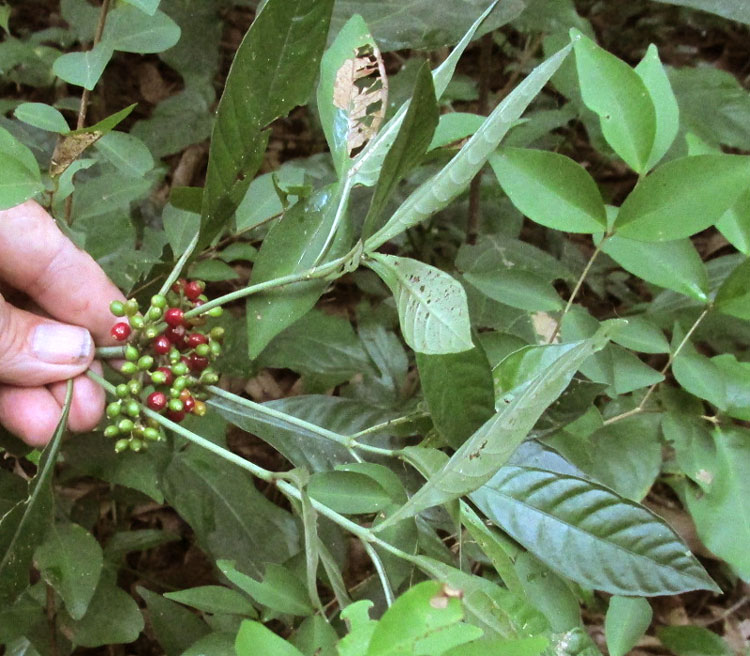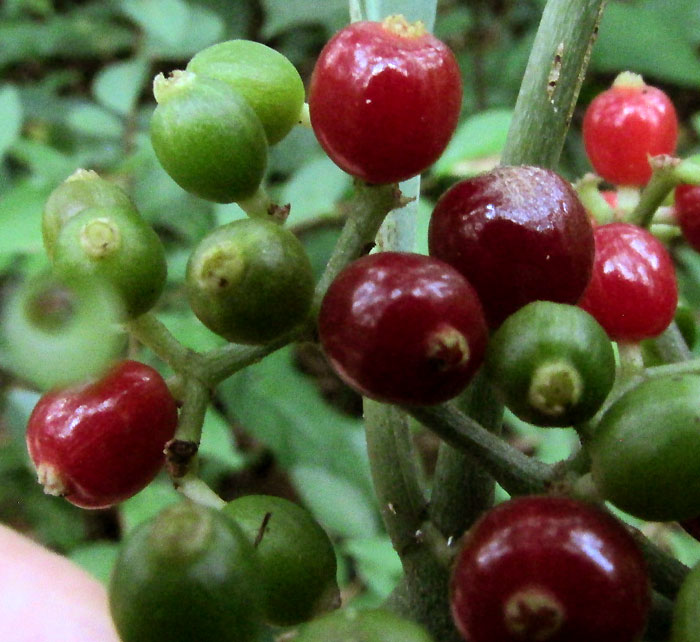Excerpts from Jim Conrad's
Naturalist Newsletter
entry from field notes dated October 7, 2022, taken about 3kms north of Gómez Farías, on the lower eastern slope of the Eastern Sierra Madres, El Cielo Biosphere Reserve, southern Tamaulipas state, MÉXICO; elevation about 300m (1000 ft), ± LAT. 23.04°N, LONG. -99.15°W
WILD COFFEE

The bush or small tree bearing the above fruiting branch leaned into the road descending into the Cañón el Azteca about 3 kms north of the village of Gómez Farías. In the humid New World tropics, when you see a bush or small tree with two simple leaves arising opposite one another at each stem node, as seen on this twig, with clusters of smallish, fleshy, more or less roundish fruits like this, the best first-bet is that it's a member of the mostly tropical and subtropical Coffee, or Madder Family, the Rubiaceae. More confirmation that we have a Coffee Family member is shown below:


Each fruit bears atop it something like a crown. That's the remains of the flower's calyx. When a flower's calyx arises above the ovary, the ovary is said to be "inferior," and Coffee Family species have inferior ovaries. Inside a ripe fruit there was just one seed, indicated by the empty fleshy part at the right.
Final proof that we have a Coffee Family member is shown below:

That's a stipule connecting the bases of two opposing leaf petioles, on a stem. A second identical stipule occurs on the stem's opposite side. Species in many families produce stipules, but such large, conspicuous ones on woody stems with opposite leaves -- that's the Coffee Family.
The Coffee Family is easy to recognize, but embracing about 660 genera and maybe around 11,150 species worldwide, with some 90 genera and more than 540 species listed for Mexico, determining the species often is daunting. In Mexico no comprehensive floras are available covering the family. The 2001 publication by A. Borhidi and N. Diego-Pérez entitled "Introducción a la Taxonomía de la Familia Rubiaceae en La Flora de México" provides keys to the tribes and genera, but it relies so heavily on obscure details such as ovule disposition that without samples of the species taken at different seasons -- no flowers now -- and no high magnification and dissecting tools, I found it unusable.
To identify our roadside bush, I felt lucky to find the 1995 work by Alfonso Valiente-Banuet and others entitled "La Vegetación Selvática de la Región de Gómez Farías, Tamaulipas, México" -- the forest vegetation around Gómez Farías -- which includes a list of species belonging to the Coffee Family. Thirteen species were listed, and by comparing pictures and information available on the Internet for each species -- even though I've found that in that work several species were overlooked -- a species turned up apparently matching our bush.
It was PSYCHOTRIA TENUIFOLIA, in English variously named Velvet-leafed Wild Coffee, Shortleaf Wild Coffee and just Wild Coffee. The species bears an English name because it occurs in Florida, though mostly it lives in moist forests in Mexico and the Caribbean region southward deep into South America, at altitudes from sea level up to about 1700m (6000 ft). Little information about the species is available, though judging from the numbers of collections turning up in online herbaria, it seems to be not only widely distributed but also commonly occurring.
Main field marks supporting our shrub's identification as Psychotria tenuifolia include the leaves' slender shape gradually tapering to the bases, and the striking "herring-bone" pattern of the leaves' secondary veins. The outer stems tend to be particularly slender and stiffly straight. The fruit's size and shape is similar to many Coffee Family species, but the fruits can contain one to many seeds, so our fruit's single seed was helpful.
Especially helpful were the stipules, for Coffee Family stipules come in many sizes and shapes, including those divided into two or more parts, those with flat tips, those bearing glands and those in which stipule pairs are united to form a sheath around the stem, those that form spines, those that remain on the stem -- you can see that our stipule is about to fall off -- on and on the variations come. I wasn't confident in the identification until high resolution online herbarium specimens showed that Psychotria tenuifolia bears broadly triangular, early-falling-off stipules identical to the one in the above picture.
Several similar-looking species are known by the name Wild Coffee, and most are members of the genus Psychotria. That genus is a big one, containing about 1582 species in the tropics worldwide, most of which are, like our Psychotria tenuifolia, understory species in moist forests. About 85 Psychotria species are listed for Mexico, with three known to occur in the forest around Gómez Farías. Accept for certain superficial similarities, the Wild Coffees of Psychotria are not closely related to the cultivated Coffee plant, which is native to Africa and Asia. Coffee plants belong to the genus Coffea, and reside in a completely different tribe from Psychotria.
Though numerous Psychotria species are documented as used in traditional medicine, and many species produce the psychedelic chemical dimethyltryptamine, or DMT, I find no reference to their dried, ground fruits serving as a coffee substitute.